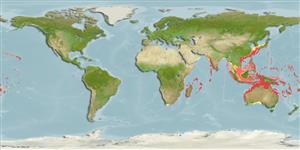Environment: milieu / climate zone / depth range / distribution range
पारिस्थितिकी
समुद्री प्रवाल-भित्ति संयुक्त; गहराई सीमा 4 - 131 m (Ref. 9710), usually 9 - 130 m (Ref. 27115). Tropical; 24°C - 28°C (Ref. 27115); 40°N - 37°S, 17°E - 155°W
Indo-Pacific: East Africa (including the Mascarene Islands, Ref. 37792) to the Hawaiian and Line islands, north to southern Japan, south to Rowley Shoals, southern Great Barrier Reef and Lord Howe Island. Absent from most of central Pacific.
आकार / वज़न / Age
Maturity: Lm ? range ? - ? cm
Max length : 54.0 cm TL पुल्लिंग / अलिंग; (Ref. 3145); common length : 35.0 cm TL पुल्लिंग / अलिंग; (Ref. 3146); अधिकतम सूचित उम्र: 30 वर्षो (Ref. 127555)
पृष्ठीय रीढ़ (सम्पूर्ण) : 9; पृष्ठीय सौफट रेज़ (सम्पूर्ण) : 25 - 27; गुदा कांटा: 3; ऐनल सौफट रेज़: 24 - 26. Pale brown body; broader, irregular lines on head; orange band between eyes, continued behind each eye to gill cover. Each side of caudal peduncle with single, sharp, forward-pointing erectile spine; spine largely covered by cream sheath; groove surrounded by a black area. Dorsal fin with soft part having longer base than spinous part. Minute scales. Gill rakers 22-26 in anterior row, 23-27 in posterior row. Caudal fin lunate in adults (Ref. 1602).
Schooling species, usually occurring in seaward reefs at depths greater than 9 m (Ref. 1602). Adults mainly on deep coastal reef slopes and outer reef walls, often on deep shipwrecks. Juveniles found on algae-rocky reef (Ref. 48637). Benthopelagic (Ref. 58302). Occur singly or in groups (Ref. 37816). Feed on surface film of fine green and blue-green algae, diatoms, and detritus covering sand (Ref. 1602). Pair-spawner (Ref. 37816). Mainly diurnal. (Ref. 1602). Utilized as a food fish (Ref. 3146).
Life cycle and mating behavior
Maturities | पुनरुत्पत्ति | Spawnings | Egg(s) | Fecundities | लार्वा
Probably spawn in pairs (Ref. 240).
Randall, J.E., 1986. Acanthuridae. p. 811-823. In M.M. Smith and P.C. Heemstra (eds.) Smiths' sea fishes. Springer-Verlag, Berlin. (Ref. 3145)
IUCN Red List Status (Ref. 130435)
Human uses
मात्स्यिकी: लघु वाणिज्य; जलजीवालय: व्यापारिक
साधन
Special reports
Download XML
इंटरनेट स्रोत
Estimates based on models
Preferred temperature (Ref.
123201): 20.3 - 28.9, mean 27.2 °C (based on 2904 cells).
Phylogenetic diversity index (Ref.
82804): PD
50 = 0.5000 [Uniqueness, from 0.5 = low to 2.0 = high].
Bayesian length-weight: a=0.03020 (0.01872 - 0.04873), b=2.94 (2.80 - 3.08), in cm total length, based on LWR estimates for this species & Genus-body shape (Ref.
93245).
Trophic level (Ref.
69278): 2.0 ±0.00 se; based on food items.
Generation time: 3.7 ( na - na) years. Estimated as median ln(3)/K based on 1
growth studies.
लौटाव (Ref.
120179): निम्न, न्यूनतम जनसंख्या दुगनी होने का समय 4.5 - 14 वर्ष। (tmax=28; K=0.29).
Fishing Vulnerability (Ref.
59153): Moderate vulnerability (36 of 100).
Nutrients (Ref.
124155): Calcium = 40.3 [16.1, 111.2] mg/100g; Iron = 0.653 [0.253, 1.583] mg/100g; Protein = 18.2 [16.8, 19.4] %; Omega3 = 0.105 [0.048, 0.219] g/100g; Selenium = 25.9 [8.9, 76.2] μg/100g; VitaminA = 31 [7, 131] μg/100g; Zinc = 2.38 [0.75, 4.33] mg/100g (wet weight);
